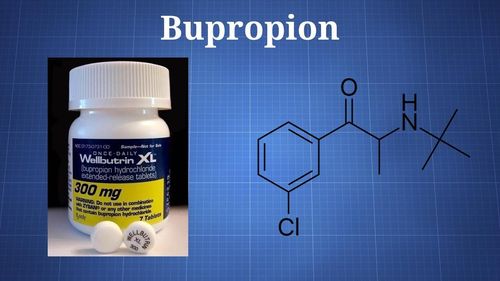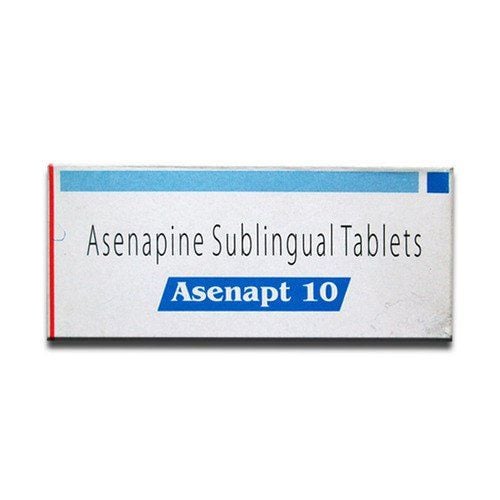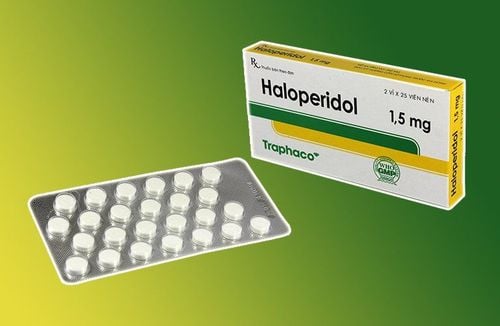This is an automatically translated article.
Halofar medicine has the main ingredient Haloperidol, which is made in the form of tablets. The drug is indicated for the treatment of mental disorders, Gilles de la Tourette's syndrome,... Let's understand the uses of Halofar and the important notes when using it in the article below.
1. What is Halofar?
Halofar medicine has the main ingredient Haloperidol 2mg with other excipients Era-pac, lactose, magnesium stearate, povidone just enough for 1 tablet. Hepaschis drug is manufactured by Pharmedic Pharmaceutical Pharmaceutical Joint Stock Company, circulated in our country with VD-33439-19. Halofar is available in the form of white round tablets with the word "HLD" on one side and "2 mg" on the bottom, and the other side has a cross-slotted, odorless side. Box of 10 blisters x 20 tablets
Pharmacodynamics
Haloperidol is a neuroleptic drug belonging to the butyrophenone group. No antihistamine or anticholinergic activity.
Pharmacokinetics
Absorption: Haloperidol is absorbed from 60 to 70% of the gastrointestinal tract after oral administration Peak concentrations are reached after about 26 hours
Distribution: Haloperidol is rapidly distributed to other tissues The average plasma concentration of haloperidol in adults is about 80-92%. Haloperidol crosses the blood-brain barrier; It also crosses the placenta and is excreted in breast milk.
Metabolism: Haloperidol is metabolised mainly through the cytochrome P450 of the liver microsomes, mainly by oxidative alkylolysis, so there is a potential for drug interactions when haloperidol is co-administered with drugs that induce or inhibit these enzymes. drug oxidation in the liver.
2. Indications and contraindications of the drug Halofar
Halofar is indicated for the treatment of the following cases:
Manifestations of mental disorders. Speech control and motor tics in Tourette's syndrome in children and adults. Treatment of severe behavioral problems in children such as agitation, aggression, assault, agitation (even without provocation). Short-term treatment in hyperactive children with behavioral disorders including the following symptoms: Obsessiveness, aggression, mood instability, difficulty concentrating and intolerance. Haloperidol is used in children when unresponsive to other antipsychotics or to psychotherapy. Halofar is contraindicated in the following cases:
Patients who are allergic to any ingredient of Halofar drug. Coma state Parkinson's disease. Dementia. Progressive supranuclear palsy. Long QT interval or congenital long QT syndrome. Recent acute myocardial infarction. Decompensated heart failure. History of ventricular arrhythmias or tachycardia. Uncorrected hypokalemia. Concomitant treatment with medicinal products that prolong the QT interval
3. Dosage of the drug Halofar
3.1. Dosage: Halofar is taken orally
3.2. Dosage: The dose of Hepaschis to be treated will vary considerably between patients. The specific dose will depend on age, previous response to other antipsychotics, and any concomitant medications or medical condition.
Children, geriatric patients, debilitated patients as well as those with a history of adverse reactions to antipsychotics, may require a lower dose of haloperidol. Optimal response in these patients is usually achieved with gradual and low dose titration.
Starting dose of treatment
For adults:
Moderate symptoms: dose is 0.5 mg - 2 mg, 2-3 times/day. Severe symptoms: dose is 3 mg - 5 mg, 2-3 times/day. In elderly or debilitated patients: dose is 0.5 mg - 2 mg, 2 - 3 times/day. In chronic or drug-resistant patients: the dose is 3 mg - 5 mg, 2 - 3 times/day. If the patient remains uncomfortable or poorly controlled, a dose adjustment may be required. In some cases, to achieve an optimal response, the daily dose may be up to 100 mg. Occasionally, patients with severe drug resistance can receive haloperidol above 100 mg. However, clinical data have not demonstrated the safety of prolonged use of this dose.
For children:
Do not give haloperidol to children under 3 years of age. Children aged 3-12 years (weight 15 kg to 40 kg): treatment should be initiated at the lowest possible dose (0.5 mg/day). If necessary, the dose can be increased by 0.5 mg increments every 5-7 days until the desired therapeutic effect is achieved. The total dose of Halofar can be divided into 2-3 times/day. For patients with mental disorders: the dose is 0.05 -0.15 mg/kg/day.
For patients with non-psychotic behavior disorder and Tourette's syndrome: the dose is 0.05 - 0.075 mg/kg/day.
In children with severe non-psychotic disorders or hyperactive children with behavioral disorders who do not respond to psychotherapy or other antipsychotics, short-term use of haloperidol may be sufficient. There is no evidence that the maximum dose of Halofar will be effective. There is little evidence that behavioral improvement is achieved at doses in excess of 6 mg/day.
Maintenance Dose: When a therapeutic response is achieved, the dose of Halofar should be gradually reduced to a level where efficacy is maintained.
3.3. Treatment of overdose, missed dose: Overdose
In case of using Halofar drug in excess of prescribed and having abnormal symptoms, it is necessary to immediately contact the nearest medical facility. The most prominent symptoms of drug overdose were severe extrapyramidal reactions, hypotension, and sedation. In severe cases, the patient will appear comatose with respiratory depression and hypotension sufficient to produce a state of shock. Therefore, it is necessary to monitor the risk of ventricular arrhythmias associated with prolongation of the QT interval.
Missed dose
During the use of Halofar, patients need to follow the doctor's treatment schedule to avoid the occurrence of missed doses that reduce the effectiveness of treatment. If you miss a dose of Halofar, use the missed dose as soon as you remember (it can be taken 1-2 hours before the time your doctor prescribes). However, if it is too close to the next dose, skip the missed dose and take the next dose exactly as prescribed. Patients should note that the dose of Halofar should not be doubled.
4. Side effects of the drug Halofar
In the process of using Halofar, you may experience some specific side effects as follows:
Common: Headache, dizziness, depression and sedation, acute dystonia, restless standing, syndrome Parkinson's disease, tardive dyskinesia occurs with long-term treatment.
Uncommon: Increased salivation and perspiration, insomnia, loss of appetite, tachycardia, hypotension, lactation, breast enlargement in men, amenorrhea or amenorrhea, constipation, dyspepsia, vomiting , dry mouth, asthenia, muscle weakness, confusion, urinary retention, blurred vision,...
Rare: Urticaria, anaphylaxis, leukopenia, agranulocytosis, thrombocytopenia, hypoglycemia, ventricular arrhythmias, hepatitis and intrahepatic biliary obstruction,...
5. Precautions when using Halofar
In the process of using Halofar, patients should pay attention to the following issues:
Elderly people with mental illness with dementia who are treated with antipsychotics have a high risk of death. QT prolongation and/or ventricular arrhythmias have been reported with haloperidol. Electrolyte disturbances such as hypomagnesaemia and hypokalemia may increase the risk of ventricular arrhythmias and should be corrected prior to treatment with haloperidol. Hypotension (including orthostatic hypotension) and tachycardia have been reported. Patients with risk factors for stroke should be used with caution. Neuroleptic Malignant Syndrome: Rare reactions characterized by hyperthermia, muscle contraction, altered consciousness, and increased blood phosphokinase clearance. Hyperthermia is often an early sign of this syndrome. Tardive dyskinesia: Tardive dyskinesia may develop in some patients during long-term treatment or after drug discontinuation. The syndrome is mainly characterized by involuntary movements of the tongue, mouth, face or jaw. The syndrome may be obscured by increasing dose or by switching to another antipsychotic. Extrapyramidal symptoms that may occur include spasticity, tremor, increased salivation, bradykinesia, dyskinesia, and acute dystonia. There have been reports of convulsions possibly caused by haloperidol. Haloperidol is metabolised in the liver, so for patients with hepatic impairment, dose adjustment and caution should be exercised. Abnormal liver function or hepatitis, often cholestasis, has been reported. Endocrine system: Thyroxin increases the toxicity of haloperidol. Use caution when treating antipsychotics in patients with hyperthyroidism. The endocrine effects of antipsychotics include hyperprolactinemia, which may cause gynecomastia in men, and amenorrhea and lactation in women. Hypoglycemia and antidiuretic hormone secretion syndrome have been reported with haloperidol. Cases of venous thromboembolism (VTE) have been reported with antipsychotics. Response to treatment and withdrawal: In schizophrenia, response to antipsychotic treatment may be delayed. If antipsychotics are discontinued, a recurrence of related symptoms may occur within weeks or months. There have been very few reports of withdrawal symptoms (including nausea, vomiting, and insomnia) following abrupt discontinuation of high doses of antipsychotics. Gradual dose reduction before discontinuing the drug is recommended as a precautionary measure. Haloperidol alone should not be used in depressed patients. May be used in combination with antidepressants for the treatment of co-existing psychosis and depression. Patients who are poor metabolizers of cytochrome P450 (CYP) 2D6 and who are taking CYP3A4 inhibitors should take Haloperidol with caution.
6. Drug interactions
Drug interactions can cause side effects or affect the action of drugs. Therefore, it is necessary to tell your doctor or pharmacist what medicines and supplements you are taking. Never increase or decrease the dose of the drug without consulting your doctor.
Halofar is contraindicated in combination with drugs that prolong the QT interval. Caution is advised when taking medicinal products that cause electrolyte imbalance in combination with Haloperidol. Drugs that may increase blood levels of haloperidol include: CYP3A4 inhibitors: fluvoxamine, alprazolam, indinavir, itraconazole, ketoconazole, nefazodone, verapamil, posaconazole, saquinavir, voriconazole. CYP2D6 inhibitors: duloxetine, bupropion, chlorpromazine, paroxetine, sertraline, promethazine, venlafaxine. Combined CYP3A4 inhibitors CYP2D6: ritonavir, fluoxetin. Drugs that may decrease haloperidol blood levels: Strong inducers of the CYP3A4 enzyme: carbamazepine, phenytoin, phenobarbital, rifampicin. The CNS depressant effect is increased when combined with methyldopa. Haloperidol may antagonize the action of other sympathomimetic products (eg, stimulants such as amphetamines) and adrenaline. In addition, Haloperidol reversed the antihypertensive effect of adrenergic blocking medicinal products such as guanethidine. Haloperidol may antagonize the effects of levodopa and other dopamine agonists. Haloperidol is an inhibitor of CYP2D6. Haloperidol inhibits the metabolism of tricyclic antidepressants (eg, desipramine, imipramine), thereby increasing their blood levels. In the process of using Halofar, patients need to pay attention to follow the doctor's instructions, carefully read the notes before taking Halofar to be able to bring the most effective treatment, limit the possible side effects. may happen.
Please dial HOTLINE for more information or register for an appointment HERE. Download MyVinmec app to make appointments faster and to manage your bookings easily.













